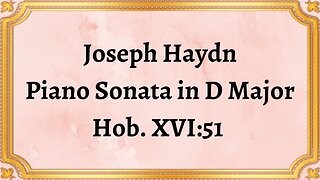Premium Only Content

Paul Hindemith Sonata No 2 For Piano (1951)
#ClassicalMusic #PaulHindemith #SonataNo2 #PianoComposition #20thCenturyMusic #GermanComposer #MusicalStructure #HarmonicLanguage #ContrapuntalTechniques #ExpressionistMusic
Publication date 1951
ZADEL SKOLOVSKY PIANO
Paul Hindemith's Sonata No. 2 for Piano is a remarkable composition that showcases the innovative spirit and complex musical language of the influential German composer. Written in the early 20th century, this piano sonata stands as a testament to Hindemith's unique approach to composition, incorporating intricate harmonies, contrapuntal techniques, and expressive elements.
Composed in 1936, during a time of great artistic experimentation and change, Sonata No. 2 reflects Hindemith's departure from the conventions of traditional tonality and his embrace of a more dissonant and expressionistic musical language. This period of Hindemith's career marked his exploration of new harmonic possibilities and a departure from the Romantic and post-Romantic styles that dominated the previous century.
Hindemith's Sonata No. 2 adheres to a traditional three-movement structure, with each movement offering a distinct character and mood. The first movement, marked as "Mäßig schnell" (moderately fast), introduces the main themes and establishes a sense of tension and urgency. The second movement, "Langsam" (slow), provides a contrasting atmosphere with its introspective and melancholic nature. Finally, the third movement, "Sehr lebhaft" (very lively), brings the sonata to a dynamic and energetic conclusion.
One of the most notable aspects of Sonata No. 2 is Hindemith's unique harmonic language. He merges tonal and atonal elements, creating a rich tapestry of dissonance and consonance. Hindemith's use of complex chords, polytonality, and chromaticism contributes to the sonata's distinct character and expressive depth. Additionally, the composition showcases Hindemith's mastery of contrapuntal techniques, with intricate melodic lines intertwining and playing off one another.
Hindemith's Sonata No. 2 is deeply expressive, with moments of introspection, turmoil, and triumph. The composition captures the emotional spectrum, ranging from introspective tranquility to passionate outbursts. Hindemith's ability to evoke a wide range of emotions through his music is a testament to his skill as a composer and his commitment to exploring the expressive capabilities of the piano.
Sonata No. 2 exemplifies Hindemith's innovative and experimental approach to composition, cementing his place as a leading figure in 20th-century music. Hindemith's exploration of dissonance, harmonic complexity, and expressive elements would go on to influence many composers who followed him. His contributions to the development of new musical structures and techniques continue to resonate with contemporary musicians and audiences.
Paul Hindemith's Sonata No. 2 for Piano stands as a testament to the composer's inventive spirit and his ability to push the boundaries of musical expression. With its intricate harmonies, contrapuntal techniques, and emotional depth, this composition captures the essence of Hindemith's unique musical language. Sonata No. 2 serves as a captivating example of Hindemith's contributions to the evolution of classical music and remains a compelling piece that invites listeners to explore the expressive depths of the piano.
You have the opportunity to support the channel:
https://destream.net/live/RadSiarAl/donate
https://www.buymeacoffee.com/6355radsiaral
-
 6:07
6:07
Classical music_Music Inspiration
3 months agoJoseph Haydn Piano Sonata in D Major, Hob. XVI:51
1311 -
 2:37:49
2:37:49
The Connect: With Johnny Mitchell
1 day ago $6.88 earnedBlackwater Mercenary EXPOSES Private Military War Secrets From The Middle East, Fueling Terrorism
31.4K29 -
 2:54:21
2:54:21
Total Horse Channel
2 days ago2025 Scottsdale Arabian Horse Show | Saturday Evening Session
67K6 -
 22:39
22:39
The Mel K Show
8 hours agoMel K & Representative Brandon Gill | Our Constitutional Republic is Being Restored | 4-26-25
52.2K43 -
 4:17:17
4:17:17
VapinGamers
8 hours ago $4.22 earned📣 Fortnite Family Night! - Games and Dubs with BrianZGame - !rumbot
39.5K3 -
 4:27:48
4:27:48
ThePope_Live
6 hours agoLIVE - First time playing The Finals in over a YEAR! Still good? with @Arrowthorn
30.7K1 -
 3:06:26
3:06:26
TruthStream with Joe and Scott
12 hours agoRoundtable with Patriot Underground and News Treason Live 4/26 5pm pacific 8pm Eastern
50.9K34 -
 8:52
8:52
Tundra Tactical
10 hours ago $9.72 earnedSCOTUS Denies Appeal, Minnesota Courts Deal 2a Win!
51.7K11 -
 10:36:01
10:36:01
a12cat34dog
12 hours agoONE WITH THE DARK & SHADOWS :: The Elder Scrolls IV: Oblivion Remastered :: FIRST-TIME PLAYING {18+}
71.3K5 -
 22:27
22:27
Exploring With Nug
18 hours ago $12.83 earnedSwamp Yields a Chilling Discovery in 40-Year Search for Missing Man!
64.5K17